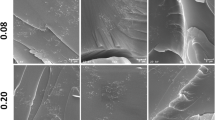Abstract
Effects of carbon fiber’s (CF’s) orientation on resistivity of CF-filled conductive composite vulcanized in electric field were investigated experimentally and theoretically. The result exhibited that the filler amount of CF and the applied electric field strength primarily determined the CF’s distribution and orientation, and corresponding resistivity features of the composite. The composite exhibited two kinds of resistivity anisotropy depending upon the combination action from driving and obstacle forces, and according distribution of CF. When a network-like structure of CF established in the composite with medium CF addition, ‘positive resistivity anisotropy’ appeared, where the resistivity in parallel direction of the electric field was lower than that in perpendicular direction. However, the resistivity in the direction parallel to the electric field was higher than that in its vertical direction when CF addition was less and all CF aligned strictly along the electric field. The same phenomenon occurred in composite with higher addition of CF where CF aligned perpendicular to the field. The latter two phenomena were all called as ‘pseudo resistivity anisotropy’. However, their resistivity mechanisms were totally different. Calculation based on effective medium theory and theory of coulomb blockade effect were applied to paraphrase this ‘pseudo resistivity anisotropy’ appeared in composite with less CF addition.














Similar content being viewed by others
References
X.J. Ding, J.W. Wang, S. Zhang, J. Wang, S.Q. Li, J. Appl. Polym. Sci. 132, 41357 (2015)
P. Carriere, S. Onard, I. Martin, J.F. Chailan, J. Appl. Polym. Sci. 132, 42078 (2015)
X. Hao, X. Qi, Z. Liu, Y. Zhou, H. Bai, Q. Zhang, Compos. Sci. Technol. 127, 54 (2016)
S. Hu, H. Li, X. Chen, C. Zhang, Z. Liu, J. Wuhan Univ. Technol. 3, 429 (2013)
H. Xiang, L.M. Zeng, C.Q. Hu, Adhesion 29, 42 (2008). (in Chinese)
E. Breval, M. Klimkiewicz, Y.T. Shi, D. Arakaki, J.P. Dougherty, J. Mater. Sci. 38, 1347 (2003)
J.K. Duan, C. Kim, P.K. Jiang, Polym. Compos. 347, 31 (2010)
E.C. Sengezer, G.D. Seidel, R.J. Bodnar, Polym. Compos. 36, 1266 (2015)
R.J. Castellano, C. Akin, G. Giraldo, S. Kim, F. Fornasiero, J.W. Shan, J. Appl. Phys. 117, 214306 (2015)
P.S. Goh, A.F. Ismail, B.C. Ng, Compos. A 56, 103 (2014)
J. Yang, J. Duan, C. Fan, P. Han, S. Shao, P. Jiang, Mater. Sci. Forum 743–744, 126 (2013)
X.Q. Chen, T. Saito, H. Yamada, K. Matsushige, Appl. Phys. Lett. 78, 3714 (2001)
T. Prasse, J.Y. Cavaillé, W. Bauhofer, Compos. Sci. Technol. 63, 1835 (2003)
M.K. Schwarz, W. Bauhofer, K. Schulte, Polymer 43, 3079 (2002)
S. Gungor, C.E. Bakis, J. Compos. Mater. 49, 535 (2014)
T.B.N. Thi, M. Morioka, A. Yokoyama, S. Hamanaka, K. Yamashita, C. Nonomurab, J. Mater. Process. Technol. 219, 1 (2015)
K. Bao, G. Yang, Aerosp. Mater. Technol. 2, 22 (1993)
L. Wang, T. Ding, P. Wang, Sens. Actuators, A 135, 587 (2007)
Y. Tsori, A. Francois Tournilhac, L. Leibler, Macromol. 36, 5873 (2003)
T. Prasse, J.Y. Cavaillé, W. Bauhofer, Compos. Sci. Technol. 63, 1835 (2003)
Acknowledgements
This study was financially supported by Enterprise Investigation Program (SGRI-WD-71-14-013).
Author information
Authors and Affiliations
Corresponding author
Rights and permissions
About this article
Cite this article
Zuo, Z., Xia, Z., Nie, J. et al. Electric anisotropy of carbon fiber-filled conductive composite vulcanized in electric field. J Mater Sci: Mater Electron 28, 3637–3647 (2017). https://doi.org/10.1007/s10854-016-5968-1
Received:
Accepted:
Published:
Issue Date:
DOI: https://doi.org/10.1007/s10854-016-5968-1




